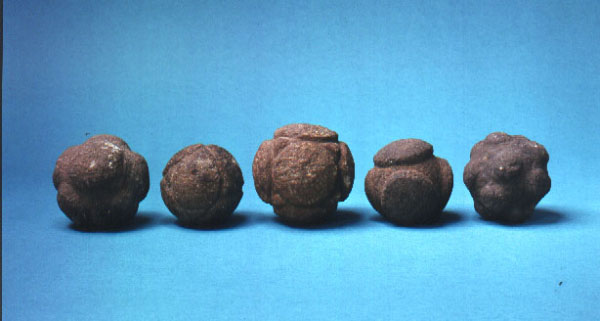Carved Stone Balls
Carved Stone Balls ( often written as: Cut, carved stone balls or engraved stone balls ) are known in slightly more than 420 copies. They originated in the late Neolithic and the Bronze Age (3500-1500 BC)
About the purpose of the stone balls, there are numerous assumptions. Usually it is believed that it was status icons.
For objects different rocks were used as hard rocks: (granite, gabbro, gneiss, diabase, diorite, quartzite ) and soft rocks ( sandstone and serpentinite ). The decoration depends on the type of stone, as hard rocks are much more difficult to shape and edit than the soft stones. Carving can be none of these rocks.
DESIGN AND PRODUCTION
The mostly spherical objects are designed carefully and elaborately and vary greatly. Most have a diameter of 70 mm. Slightly more than a dozen are between 90-114 mm. Many are almost round and a few oval. Most have six knobs, the best-designed balls have four knobs and the other have a different number on. The orkadischen have the most knobs and soft partly completely from the spherical shape from. The size of the frequently decorated with engraved patterns knobs varied. The patterns consist of linear, spiral or concentric engravings. There are also balls without ornaments.
Found in Kilmaurs, Scotland
Found in 1933 in Golspie, Scotland
The researcher Andrew T. Young has found in an experimental, scientific investigation that the Scottish stone balls with prehistoric tools, without the use of metals, could be shaped.
Initial investigations and Locations
FR Coles, an employee of the National Museum of Antiquities of Scotland, examined 1897-1911 about 180 stone balls and published the result in 1911. A further employee of the museum, Bulmer, made to drawings.
Dissemination
Most were found in northern Scotland in Aberdeenshire, between the Moray Firth and Tay River in the Grampian Mountains and Skara Brae on Orkney. There were also findings in Ireland and England. Carved Stone Balls found in Aberdeenshire, Dunadd, Hawick, Wigtownshire on Iona, Skye, Lewis and Harris, Uist, Arran and Orkney. Outside of Scotland in Ireland in Ballymena and in England at Durham, Cumbria, Lowick and Bridlington. Decorated with seven studs balls of diorite, which were found in Hill Head, near St. Ola, Orkney, come from Wick Hill to the Shetlands. Five Carved Stone Objects were on Orkney in the Stone Age settlement of Skara Brae, which was declared a UNESCO World Heritage Site, have been found.
Many functions for these objects have been proposed, they may have been attached to shafts mace heads. Regardless of their function they were prestigious possessions and symbols of power.









